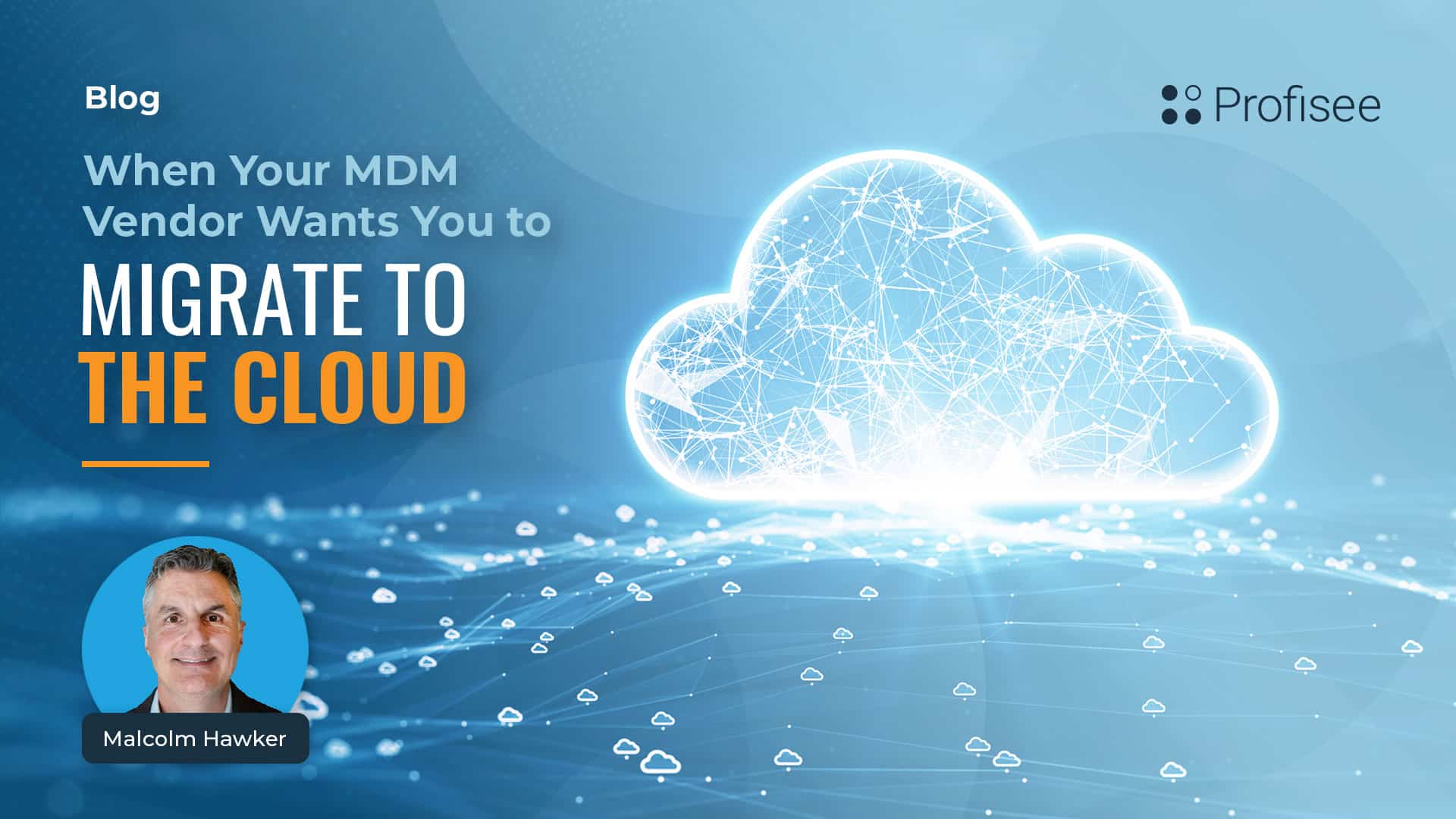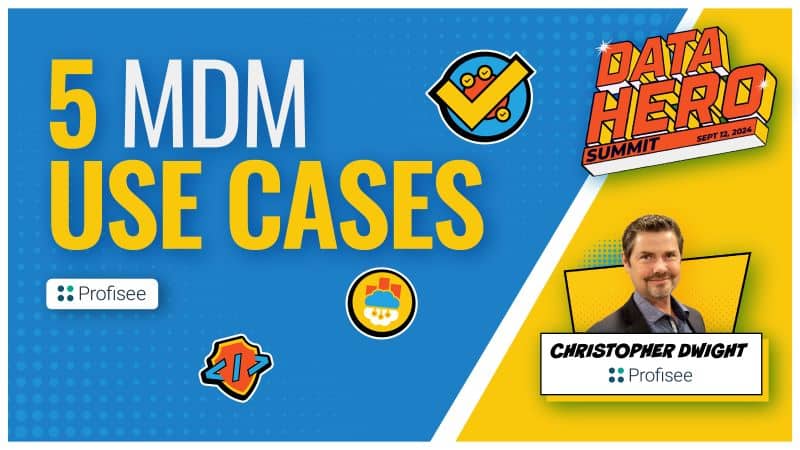Table of Contents
- What to Consider Before Migrating Your MDM Solution to the Cloud
- Use a Framework to Understand the Impact of Migrating Your MDM Solution to the Cloud
- Choosing the Optimal Path to MDM Based on Your Unique Business Needs
- Designing a Focused Proof of Concept (PoC) to Streamline Evaluation
- How Profisee Can Help
- Read the Full Blog on Selling MDM to Leadership
- MAKE IT EASY WITH SIMPLIFIED MDM
Do you feel like you’re being forced to migrate your master data management (MDM) software to the cloud? Has your vendor given you what sounds like an ultimatum to migrate to a cloud-based solution?
If yes, then you’re not alone.
As MDM vendors migrate their core solutions to the cloud, many companies using those solutions find themselves having to make some difficult choices — which they often didn’t plan for.
What to Consider Before Migrating Your MDM Solution to the Cloud
To receive ongoing updates, or to continue receiving support and maintenance for their MDM products, companies facing an unplanned cloud migration proposed by their MDM vendors are being forced to evaluate several important factors, including:
- Does the timing of an MDM cloud migration proposed by a vendor align to the roadmap for any pre-existing cloud migration plan?
If not, and your roadmap requires that more time passes before migrating your MDM, will the vendor continue to support the legacy deployment, or will running on the legacy MDM deployment — that may now by end-of-life — introduce an undesired level of business risk?
2. Is the cloud version of the MDM software the same software running in the legacy deployment? If not, what’s different?
Will there be an investment in end-user training required to support the migration to the newer, cloud-based version? If the cloud-based MDM software is running on a totally different codebase, how disruptive will this change be for other organizations, including data stewards outside IT or others who may interact with the MDM?
3. How different (if at all) is the data model for the cloud-based version as compared to the legacy deployment?
Can the cloud version of MDM support the legacy MDM data model? If not, is the organization ready to revisit its data governance policies for master data to ensure the new data model aligns to those policies? Will stakeholders outside IT be willing to apply resources to support this work?
DATA INSIGHTS,
DIRECT TO YOUR INBOX
4. What operational considerations must be made to support a cloud migration that hasn’t been necessary as compared to the legacy deployment?
For example, will a cloud migration require an operational or security review? Are other groups within IT — such as security or compliance — aligned to support this work? Can the cloud version support requirements for data residency, business continuity, and data privacy/security? If not, are these requirements a dealbreaker?
5. What impacts will an MDM cloud migration have on other data management tools supporting the master data workflows – particularly data integration, data governance, and data quality?
How much work will be required to ‘re-plumb’ the connection between a legacy MDM and the new cloud-based MDM and these other important aspects of data management?
6. What level of vendor support is provided to help with the cloud migration?
Are third-party consultants typically involved, how long will the migration take, and how much will it cost? Will these costs be offset by the added benefits of the migration — or will this be seen as a net negative from an ROI perspective?
7. Does the cloud migration require a new license agreement?
If yes, is the company willing to recommit to the MDM vendor on another agreement? If yes, does the new license represent a more flexible or business-friendly approach to pricing, or does the new MDM license model penalize usage?
Use a Framework to Understand the Impact of Migrating Your MDM Solution to the Cloud
When the answers to these questions are considered and finalized, most companies will likely find themselves somewhere in this 2×2 matrix that factors both the level of effort associated with cloud migrations (vertical axis) and the level of disruption associated with the cloud migration (horizontal access) and groups organizations into three distinct categories:
The Green Zone: Low Disruption AND Low Effort
Companies in the ‘green’ zone will likely find their MDM migration a relatively trivial exercise — one that can be planned on their schedule, with low levels of business or IT disruption, and at minimal cost. Companies in this zone will all generally proceed with the migration, and recommit to a new, longer-term agreement with their MDM vendor.
The Blue Zone: Low Disruption OR Low Effort
Companies in the ‘blue’ zone will be forced to weigh the pros and cons of the migration, and as a result will have far more diligence, planning (including with groups outside IT), and budgeting than any companies in the green zone. Ultimately for these companies, there will likely be acceptable tradeoffs that will help to make the cloud migration tolerable — albeit slightly more costly and disruptive than preferable or planned.
The Orange Zone: High Disruption AND High Effort
Companies in the ‘orange’ zone will face a difficult choice. If the level of disruption, total cost, and perceived total benefits of the cloud migration for MDM are all sub-optimal, will that company continue to do business with their current MDM provider?
Choosing the Optimal Path to MDM Based on Your Unique Business Needs
If faced with a new application, a new MDM data model, a disruptive migration, and high migration costs associated with a cloud migration — I recommend that companies explore their options for alternative MDM solutions.
This is because the cloud migration essentially represents a net new solution, and if that’s indeed the case, then other providers may be better suited to meet a company’s long-term MDM needs. Some MDM vendors may even be able to support requirements for on-prem deployments of MDM and not necessarily require a cloud migration.
Taking the time to reconsider your MDM vendor makes even more sense for anyone who was previously unhappy with their vendor relationship. If your relationship isn’t strong, and your vendor is aggressively pushing you to make a cloud migration that may not otherwise fully align to your strategy or short term-plan, then does making a recommitment to that vendor represent your best option? Very likely the answer here is ‘no’.
Designing a Focused Proof of Concept (PoC) to Streamline Evaluation
However, changing MDM providers is not itself without costs and disruptions. A major consideration here is the degree to which you are using your current MDM vendor to support operational MDM use cases. If the master data in your MDM hub is being used extensively by downstream solutions within existing business processes, switching MDM vendors will be highly disruptive — potentially more so as compared to your cloud migration. Switching MDM vendors if you’re only supporting analytical use cases will be relatively trivial by comparison to any situation where your master data is used operationally.
If you’ve evaluated the cost/benefit of your cloud migration, compared it to the cost of switching vendors, and you’re open to making a vendor switch, then a great approach is to consider using a new vendor in a limited-scope POC. A new vendor supports an MDM process while the legacy deployment continues to support most MDM workflows.
This ‘try before you buy’ approach with new MDM solutions is increasingly common with companies amid highly disruptive ERP migrations or consolidations. A new cloud-native MDM solution from a vendor with a strong track record of quick and easy cloud deployments will have a distinct advantage over other solutions that align more to the red zone in the graphic above.
How Profisee Can Help
If you do consider making a vendor change because of the costs, risks, and disruptions your incumbent vendor is introducing because of a cloud migration, Profisee has several online resources available to help — including an RFP template, best practices recommendations in blogs, videos, and other online tutorials — and support for building MDM business cases.
Read the Full Blog on Selling MDM to Leadership
The journey to trusted data encompasses much more than MDM vendor selection — you need a solid business case that compels business leaders to take action. Read our comprehensive blog on Selling MDM to Leadership to learn more.
Malcolm Hawker
Head of Data Strategy @ Profisee
MAKE IT EASY WITH SIMPLIFIED MDM

Malcolm Hawker
Malcolm Hawker is a former Gartner analyst and the Chief Data Officer at Profisee. Follow him on LinkedIn.
















